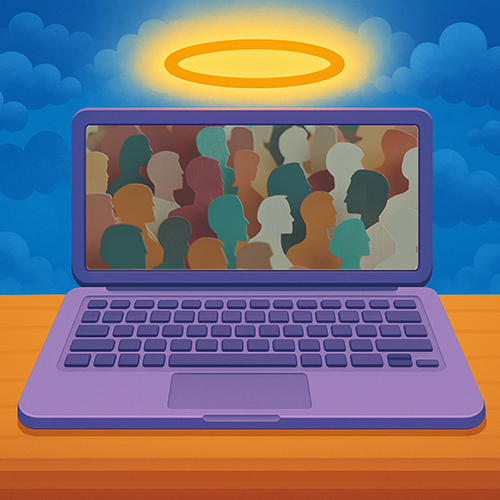Mikkel Borch-Jacobsen is no stranger to controversy. His books, including a recent volume on Freud and his latest on the history of mental illness, have certainly stirred things up. While historians of psychology and psychiatry laud them, a volume published in France angered that country's mental health community so much that “I’ve become a kind of Satan for them,” admits Borch-Jacobsen.
A UW professor of French and comparative literature likened to Satan? For Borch-Jacobsen, it’s simply the price paid for arguing a controversial position.
Borch-Jacobsen’s research has long focused on mental health in an historical perspective. His latest volume, Making Minds and Madness: From Hysteria to Depression (Oxford University Press), explores how psychological conditions appear, gain in popularity, and then fall out of favor. He argues that many mental health conditions are as much a social construct as medical diagnosis, with doctors or therapists and their patients creating them together.

“There are certainly serious conditions, like schizophrenia and manic depression, that are not a social construction,” says Borch-Jacobsen. “On the other hand, we have this whole area of odd illnesses that have no organic foundation. They come and go, historically speaking.”
Borch-Jacobsen points out that mental illness as a social construct dates back to the late Renaissance, when one young girl’s convulsions—a condition previously attributed to the Devil—was first diagnosed as a medical condition, “hysteria”. This groundbreaking diagnosis has often been hailed as an advance of medical science over superstition, but Borch-Jacobsen says that it was nothing of the sort. In reality, he says, the diagnosis came at the behest of the powerful Bishop of London, who wanted to quell religious agitation around the stricken child’s case. “It was just an ad hoc argument used in the context of the religious and political struggles of the time,” says Borch-Jacobsen. “But it marks the beginning of the gradual medicalization of all kinds of behaviors that were defined until then in religious terms.”
Skipping ahead to the 20th century, Borch-Jacobsen identifies a whole boatload of psychological disorders that appear and disappear as specific medical and psychiatric theories and treatments gain or lose popularity. He devotes a chapter to depression, a condition he says was relatively rare until a recent upsurge. He notes that the rise in depression corresponds with the introduction of antidepressant medications in the 1960s, with the number of depression diagnoses skyrocketing as more targeted medications appeared in the late 1980s.
“This is clearly not a coincidence,” says Borch-Jacobsen. “Far from arriving on the market to treat a previously existing psychiatric disorder, these new drugs actually promoted it. Modern, Western depression, we might say, is a side effect of antidepressants.”

It might seem like patients are pawns in such a scenario, but Borch-Jacobsen argues that they are key players in the growing popularity of various disorders. “The creation of a syndrome requires a very active collaboration on the part of the patients,” he says, offering the diagnosis of depression again as an example. “Indeed, unless we assume that depression was always there, waiting to be ‘revealed’ by antidepressants, the patients must have recognized themselves in this new symptomatology and told themselves that they were indeed depressed. …Patients, in other words, are not passive.”
Borch-Jacobsen also discusses psychotherapists’ tendency to let their own biases influence their diagnoses. Freud in particular, he says, exerted the power of suggestion on his patients through his targeted questions and theoretical expectations. “What Freud did, in a similar manner to other late 19th century and 20th century psychotherapies, was to form a self-confirming apparatus which would produce—suggest—evidence for whatever theory he liked.”
In the 21st century, Borch-Jacobsen sees the influence of psychotherapists waning, with the pharmaceutical industry taking on an ever greater role in defining new conditions. As companies develop more sophisticated treatments that target specific neurotransmitters or genes, he anticipates more conditions emerging that are said to benefit from those treatments.
“From my vantage point, much of what biopsychiatry produces today are not so much cures as, once again, new diseases, new ways of making minds and madness,” he says. "Each pill, each molecule creates a new condition—and a new market for pharmaceutical and biotech companies.”
If the mental health community was unhappy with Borch-Jacobsen’s last book, the pharmaceutical industry is sure to chafe at his next offering, which will explore the growing influence of the industry on mental illness diagnosis and treatment. The book is currently in the research stage.
"I’m not the only one coming to these conclusions," says Borch-Jacobsen. "More and more people in psychiatry and medical anthropology are expressing the same concerns.”
More Stories

The Public Impact of Private Cities
Geography major Edwin Bai has researched private cities, developed by individuals and corporations, that "take the libertarian idea of low government regulation to the maximum."

The Curious Journey of Chinese Characters
Several Asian countries adapted the Chinese writing system—the oldest writing system still in use—for their own languages. In a new book, Professor Zev Handel shares how that happened.

Can Machines Learn Morality?
UW researchers at the Institute for Learning & Brain Sciences and in the Allen School are exploring the potential for training AI to value altruism.